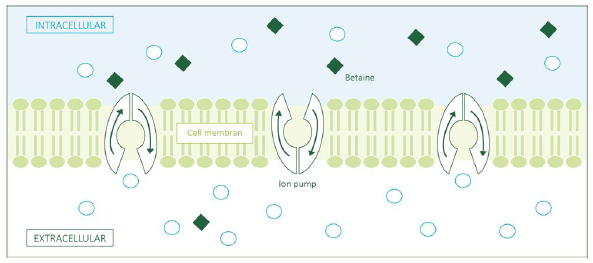Betaine anhydrous is an underestimated multi-talent
On the metabolic level, betaine (trimethylglycine) is a highly efficient methyl group donor and is widely used to replace choline chloride in this function. A high dosage will save methionine by re-methylating homocysteine, which opens the opportunity to adjust the methionine level closer to the requirements for protein synthesis. After donating one methyl group to re-methylate methionine, the resulting dimethylglycine ends up as glycine in the amino acid pool. This increases the availability of glycine, which is a non-essential but nonetheless limiting amino acid in low protein diets. Before betaine enters the metabolism, intestinal enterocytes are using its osmotic properties to improve and strengthen their cell function.
Osmotic effect of betaine
The physiologically beneficial form of betaine, betaine anhydrous, is known as a compatible osmotic regulator which may exhibit several positive effects in animals. It is efficiently absorbed and can be accumulated in the enterocytes to optimize the osmoregulation based on actual needs. This includes the potential to reduce the demand for sodium potassium pump activity, the common system for osmoregulation. This effect will improve litter quality and diminish the negative effects of heat stress on animal health and performance. The physiological reactions to heat stress, such as panting and increased water intake, are more efficient and less excessive.

Figure 3: Osmotic effect of betaine
Betaine exerts an osmoprotective effect by accumulating in cell organelles and in cells when exposed to osmotic and ionic stress, thereby replacing inorganic ions, and thus protecting enzymes as well as cell
membranes from inactivation by inorganic ions. Compatible osmolytes increase the cytoplasmic volume and free water
content of the cells at high osmolarity, and thus permit cell proliferation under stress conditions. Additionally, betaine serves as a stabilizer of protein and cell components against the denaturing effects of high ionic strength.
The presence of betaine in the intestinal tissue may reduce the energy requirement for ion pumping, hence lowering the energy requirement for maintenance and providing more energy for intestinal cell proliferation (Siljander-Rasi et al., 2003). Accordingly, the accumulation of betaine increased water-binding capacity of the intestinal cells and promoted changes in the structure of the intestinal epithelium (Kettunen et al., 2001).
Practical application in feed
A pure betaine anhydrous product like Hepatron® N96% was used in a trial conducted in cooperation with a compound feed manufacturer in the Netherlands to confirm the effectiveness as a performance enhancer and alternative methyl group donor, by replacing part of the added methionine with Hepatron® N96%.
The trial was conducted in one house split in two compartments with 3000 birds (Ross 308, mixed sex) in each department. The trial was executed twice (1st run, 2nd run), one after the other. In order to exclude an influence of the compartments, they were switched between the two runs. The growing period of both groups was divided into 4 feeding phases: Starter: day 0 – 9, Grower I: day 10 – 20, Grower II: day 21 – 27, Finisher: day > 27.
In the first run, birds of the control group received a standard diet based on wheat, maize and soy, whereas the birds of the trial group received this standard diet with a reduction of the methionine content (-1.05 g/kg) and an addition of 1 gr Hepatron® N96% per kg final feed. After receiving positive results, a second run was conducted in which the control feed already had a slightly reduced methionine content. For details of nutritional values see table 1.

In both runs, the trial groups showed better results for all measured parameters. Bad chick quality increased the mortality rate in both groups. Detailed performance data are presented in table 2. The use of Hepatron® N96% improved broilers’ performance remarkably, despite the reduced methionine content. The output per house in terms of life weight delivered to the slaughterhouse increased by 3.7% and resulted in EUR 0.045 higher earnings per bird. Under current market conditions, the addition of Hepatron N96% to the feed will not be fully compensated by the reduction of DL- Methionine and creates extra costs of EUR 0.005 per bird resulting in an EUR 0.04 increased net profit per bird.

Conclusion
Hepatron N96% is a highly efficient betaine anhydrous product derived from sugar beets. It is a highly efficient methyl group donor and supports the amino acid availability in low protein diets. 0.8 to 1 kg per ton feed are recommended to create the osmotic effects which have the potential to improve nutrient efficiency and overall performance. This is of great advantage during any kind of stress situations but also will pay off under good environmental conditions. Adaptions in methionine supplementations and other nutrients have to be done based on the individual situation.